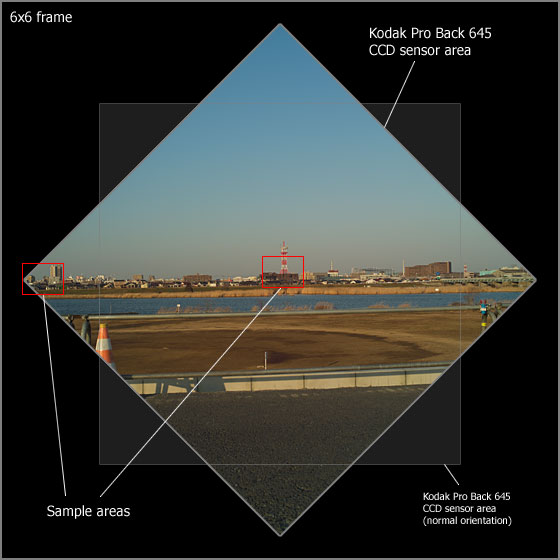Size of the Kodak Pro Back 645 CCD sensor:

The Kodak Pro Back 645 has a 36.72mm x 36.72mm sensor and produces an image that is 4072 x 4072 pixels. Because this is still only 85% the area of a 6x6 film frame, I rotated the camera 45-degrees so the captured images are diamond shaped. This allowed me to look at an area that is closer to the horizontal edge of a normal 6x6 frame.
An 18MB to 19MB DCR (RAW) file is saved to the memory card and then converted into a 48.5MB TIFF file using Kodak's DCS Photo Desk software. I then opened these in Photoshop and rotated them 45-degrees to straighten out the horizon, before taking 400 x 300 pixel samples from the center and edge. These samples were saved in JPEG format using Photoshop's "Maximum" and "Quality: 80" settings for reasonable Internet download times. No sharpening or color adjustments were performed.
Methodology:
The test set up was a Contax 645 with Kodak Pro Back 645 mounted onto a Wimberley Arca-style quick release plate and Graf Studioball ballhead on Gitzo L-407 legs. The camera was fired with a cable release. For the 500mm lenses in particular, I used the self-timer because it pre-fires the mirror, in conjunction with the cable release to achieve maximum sharpness.
The lenses were mounted to the camera via a Pentacon 6 - Contax 645 mount adapter. The Hasselblad lenses were attached with a Hasselblad - Contax 645 adapter. There is no known Bronica SQ - Contax 645 adapter, but placing the lenses directly against the Pentacon 6 adapter happened to give perfect infinity focus. However, since there was no way to actually secure the Bronica lenses, I had to hand hold them in place which means that: their positioning varies slightly from shot to shot, their potential contrast and color may very well have suffered due to stray light entering the small gaps between the lens and the adapter, and overall sharpness could have been adversely affected due to hand shake. Nonetheless, I think the results from the Bronica lenses are quite respectable, even if they cannot be trusted 100%.
For each lens, I took a series of pictures at its widest aperture, and stopped down to two other aperture settings -- usually F5.6 and F11, or F8 and F16 depending on the lens. I then threw the lens out of focus, refocused, and took another series of photos. This was repeated a third time, and up to as many as eight times in the case of the 250mm and 500mm lenses. The Zeiss Jena Biometar and Schneider Xenotar also got special attention with a total of 15 re-focuses each in order to eliminate the possibility of focus error.
Countless hours over 6 weekends, 46 lenses, about 800 images, and about 54 Gigabytes of image data later, and the sharpest set of images from each lens are presented on the following pages.
And now, on to the tests!
| 
